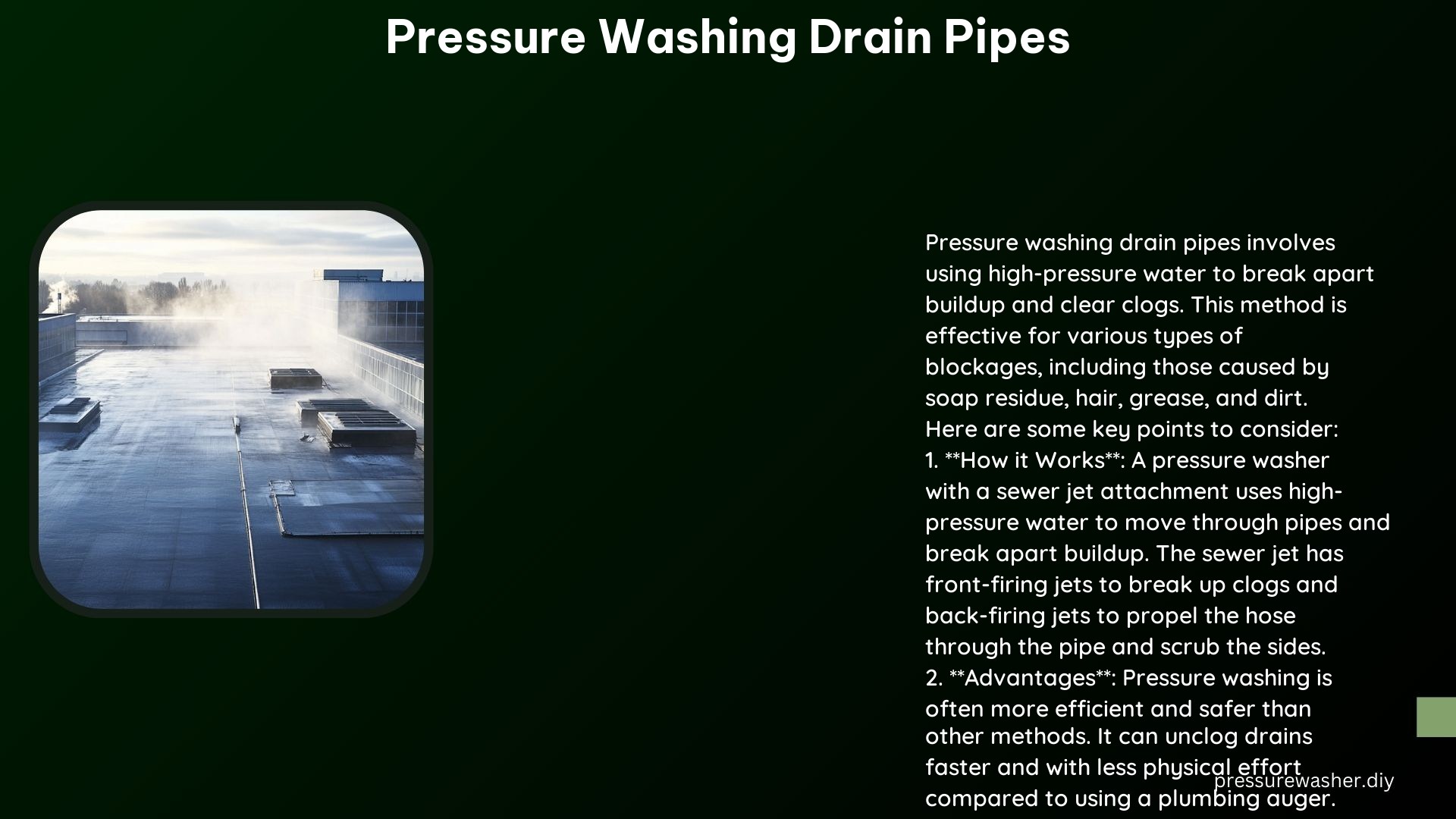Pressure washing drain pipes is an effective and efficient method for unclogging and cleaning clogged drains. This comprehensive guide delves into the technical details, benefits, and practical applications of using pressure washers to maintain your home’s plumbing system.
How Pressure Washing Works
The principle behind pressure washing drain pipes is the use of high-pressure water to dislodge and flush out built-up debris, rather than relying on the pressure within the pipe itself. This is achieved through the use of a specialized attachment known as a sewer jetter.
Sewer Jetter Attachment
A sewer jetter is a long, flexible hose with a jet nozzle on one end and a coupling on the other. The nozzle is designed with both front-firing and back-firing jets. The front-firing jets are responsible for breaking up and dislodging clogs, while the back-firing jets propel the hose through the drain, simultaneously scrubbing the pipe walls.
The sewer jetter is connected to the pressure washer, allowing the high-pressure water to be directed through the hose and into the drain. This powerful stream of water can effectively clear even the most stubborn blockages, such as grease buildup, tree roots, and accumulated debris.
Benefits and Types of Pressure Washers

Pressure washing drain pipes offers several key benefits over traditional plumbing methods, making it an increasingly popular choice for homeowners and professionals alike.
Benefits
- Efficiency: Pressure washers are generally faster and easier to use than plumbing augers, and they can clean the pipe walls more effectively, ensuring a thorough and complete cleaning.
- Safety: Pressure washing is a safer alternative to chemical drain cleaners and plumbing augers, which can potentially damage pipes or expose users to toxic substances.
Types of Pressure Washers
- Electric Pressure Washers: Suitable for indoor use, electric pressure washers typically have lower flow rates (less than 2 GPM) and are generally less expensive than gas-powered models.
- Gas-Powered Pressure Washers: More powerful and suitable for outdoor use, gas-powered pressure washers often have higher flow rates and are commonly used for larger drain cleaning projects.
Technical Specifications
When selecting a pressure washer for drain cleaning, it’s important to consider the following technical specifications:
Flow Rate
- Electric pressure washers typically have a flow rate of around 2.4 GPM (Gallons Per Minute).
- Gas-powered pressure washers often have higher flow rates, ranging from 3 to 5 GPM or more, depending on the model.
Pressure
- Pressure washers used for drain cleaning typically have a pressure range of 1,000 to 4,000 PSI (Pounds per Square Inch).
- The higher the pressure, the more effective the cleaning power, but it’s important to choose a pressure washer that is appropriate for the specific job and pipe material.
Hose Length
- Sewer jetter hoses can vary in length, ranging from 50 to 100 feet or more, depending on the specific kit or attachment.
- Longer hoses allow for greater reach and accessibility, making them suitable for clearing blockages in longer or harder-to-reach drain lines.
Real-Life Examples and Tips
Pressure washers have proven to be highly effective in clearing clogged sewer lines and drains, even in challenging situations.
Success Stories
- In one instance, a 4,000 PSI pressure washer was used to clear a sewer line that had been blocked by instant potato flakes, demonstrating the power and versatility of this cleaning method.
Tips
- Use the Right Nozzle: Different nozzle designs are optimized for specific tasks, such as forward-firing jets for breaking up clogs and back-firing jets for propelling the hose through the drain and scrubbing the pipe walls.
- Choose the Right Pressure Washer: Select a pressure washer model that is appropriate for the job at hand, considering factors like flow rate, pressure, and hose length to ensure optimal performance and efficiency.
Additional Resources
For those interested in starting a pressure washing business or expanding their expertise in this field, there are various training and mentoring opportunities available, as well as a wide range of equipment and supplies to explore.
Training and Mentoring
- Online video schools and classes offer comprehensive training on pressure washing techniques, including specialized modules on drain cleaning.
- Experienced pressure washing professionals may also provide mentorship and guidance to those new to the industry.
Equipment and Supplies
- Numerous online stores offer a wide selection of pressure washing equipment and accessories, including specialized sewer jetter attachments, hoses, and cleaning solutions tailored for drain cleaning applications.
By understanding the technical details, benefits, and practical applications of pressure washing drain pipes, homeowners and professionals can effectively maintain their plumbing systems, prevent costly clogs, and ensure the smooth and efficient flow of water through their homes.
References:
– Trusteyman. (2021). Unclogging the Drain: Should You Use a Pressure Washer? Retrieved from https://trusteyman.com/blog/unclogging-the-drain-should-you-use-a-pressure-washer/
– Pressure Washers Direct. (n.d.). How to Clear Sewer and Drain Pipes. Retrieved from https://www.pressurewashersdirect.com/stories/905-How-to-Clear-Sewer-and-Drain-Pipes.html
– Amazon. (n.d.). STYDDI Sewer Jetter Kit for Pressure Washer 100FT, 1/4 Inch NPT. Retrieved from https://www.amazon.com/STYDDI-Pressure-Rotating-Drainage-Downspouts/dp/B082V6C589
– Reddit. (2023). Pressure washer in pipes? : r/Plumbing. Retrieved from https://www.reddit.com/r/Plumbing/comments/17bqcga/pressure_washer_in_pipes/
– YouTube. (2021). Drain Cleaning with Pressure Washer from Doug Rucker. Retrieved from https://www.youtube.com/watch?v=cCM94UclxU4
